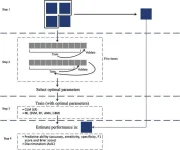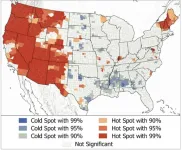(Press-News.org) Bridging precision engineering and precision medicine to create personalized physiology avatars. Pursuing on-demand tissue and organ engineering for human health. Revolutionizing neuroscience by using AI to engineer advanced brain interface systems. Engineering the immune system for health and wellness. Designing and engineering genomes for organism repurposing and genomic perturbations.
These are the five research areas where the field of biomedical engineering has the potential to achieve tremendous impact on the field of medicine, according to “Grand Challenges at the Interface of Engineering and Medicine,” a study published by a 50-person task force published in the latest issue of IEEE Open Journal of Engineering in Medicine and Biology. The paper is backed by the IEEE Engineering in Medicine and Biology Society.
“These grand challenges offer unique opportunities that can transform the practice of engineering and medicine,” said Shankar Subramaniam, lead author of the taskforce, distinguished professor in the Shu Chien-Gene Lay Department of Bioengineering at the University of California San Diego. “Innovations in the form of multi-scale sensors and devices, creation of humanoid avatars and the development of exceptionally realistic predictive models driven by AI can radically change our lifestyles and response to pathologies. Institutions can revolutionize education in biomedical and engineering, training the greatest minds to engage in the most important problem of all times – human health.”
In addition to Subramaniam, the following faculty from the UC San Diego Shu Chien-Gene Lay Department of Bioengineering were part of the task force: Stephanie Fraley, associate professor, Prashant Mali, professor, Berhard Palsson, Y.C. Fung Endowed Professor in Bioengineering and professor of pediatrics, and Kun Zhang, professor and a former department chair.
The study provides a roadmap to pursue transformative research work that, over the next decade, is expected to transform the practice of medicine. The advances would impact a wide range of conditions and diseases, from cancer, to diabetes, to transplants, to prosthetics.
The Five Grand Challenges Facing Biomedical Engineering
Bridging precision engineering and precision medicine for personalized physiology avatars
In an increasingly digital age, we have technologies that gather immense amounts of data on patients, which clinicians can add to or pull from. Making use of this data to develop accurate models of physiology, called “avatars” – which take into account multimodal measurements and comorbidities, concomitant medications, potential risks and costs – can bridge individual patient data to hyper-personalized care, diagnosis, risk prediction, and treatment. Advanced technologies, such as wearable sensors and digital twins, can provide the basis of a solution to this challenge.
The pursuit of on-demand tissue and organ engineering for human health
Tissue engineering is entering a pivotal period in which developing tissues and organs on demand, either as permanent or temporary implants, is becoming a reality. To shepherd the growth of this modality, key advancements in stem cell engineering and manufacturing – along with ancillary technologies such as gene editing – are required. Other forms of stem cell tools, such as organ-on-a-chip technology, can soon be built using a patient’s own cells and can make personalized predictions and serve as “avatars.”
Revolutionizing neuroscience using artificial intelligence (AI) to engineer advanced brain-interface systems
Using AI, we have the opportunity to analyze the various states of the brain through everyday situations and real-world functioning to noninvasively pinpoint pathological brain function. Creating technology that does this is a monumental task, but one that is increasingly possible. Brain prosthetics, which supplement, replace or augment functions, can relieve the disease burden caused neurological conditions. Additionally, AI modeling of brain anatomy, physiology, and behavior, along with the synthesis of neural organoids, can unravel the complexities of the brain and bring us closer to understanding and treating these diseases.
Engineering the immune system for health and wellness
With a heightened understanding of the fundamental science governing the immune system, we can strategically make use of the immune system to redesign human cells as therapeutic and medically invaluable technologies. The application of immunotherapy in cancer treatment provides evidence of the integration of engineering principles with innovations in vaccines, genome, epigenome and protein engineering, along with advancements in nanomedicine technology, functional genomics and synthetic transcriptional control.
Designing and engineering genomes for organism repurposing and genomic perturbations
Despite the rapid advances in genomics in the past few decades, there are obstacles remaining in our ability to engineer genomic DNA. Understanding the design principles of the human genome and its activity can help us create solutions to many different diseases that involve engineering new functionality into human cells, effectively leveraging the epigenome and transcriptome, and building new cell-based therapeutics. Beyond that, there are still major hurdles in gene delivery methods for in vivo gene engineering, in which we see biomedical engineering being a component to the solution to this problem.
“We are living in unprecedented times where the collision of engineering and medicine is creating entirely novel strategies for human health. The outcome of our task force, with the emergence of the major research and training opportunities is likely to reverberate in both worlds--engineering and medicine--for decades to come” said Michael Miller, Professor and Director of the Department of Biomedical Engineering at Johns Hopkins University, who served as a senior author on the manuscript.
END
Study details five cutting-edge advances in biomedical engineering and their applications in medicine
Alliance of 50 experts from 34 elite universities reveals pioneering engineering advance across five vital domains
2024-02-28
ELSE PRESS RELEASES FROM THIS DATE:
Traditional regression approach outperformed machine learning algorithms in predicting optimal surgical method in patients with submucosal tumors.
2024-02-28
Submucosal tumors (SMTs) are usually found in the stomach and esophagus during an upper endoscopy. Submucosal tunneling endoscopic resection (STER) and non-tunneling endoscopic resection (NTER) are the two most commonly used techniques in the treatment of gastric and esophageal SMTs. As novel technologies continue to shape the medical landscape, machine learning (ML) algorithms find increased application, demonstrating enhanced performance in various fields. Although some studies have evaluated the incremental value of flexible ML methods, comparisons with traditional logistic regression (LR) models are lacking.
To this end, a recent study by a team of researchers from China published in the ...
A survey on federated learning: A perspective from multi-party computation
2024-02-28
Federated learning (FL) has emerged as a popular machine learning paradigm which allows multiple data owners to train models collaboratively with out sharing their raw datasets. It holds potential for a wide spectrum of nalytics applications on sensitive data. For example, federated learning has been applied on medical big data analysis such as disease prediction and diagnosis without revealing the patients’ private medical information to thirdparty services. It has also been exploited by banks and insurance ...
New pediatric cancer marker, new hope for a treatment target
2024-02-28
Researchers have newly identified a universal, essential biomarker for the childhood cancer neuroblastoma – and a potential new target for treatment.
Neuroblastoma accounts for 15% of all pediatric cancer deaths and is the most common source of childhood tumors outside of brain cancer. The disease develops in early nerve tissue, usually in and around the adrenal glands, and typically affects children under age five. High-risk cases have a five-year survival rate of just 50%.
Led by UC San Francisco, researchers suspected the oncoprotein AF1q, which is known to play a role in leukemia and solid tumor progression, might be important in tumors of neural origin ...
Could we assess autism in children with a simple eye reflex test?
2024-02-28
Scientists at UC San Francisco may have discovered a new way to test for autism by measuring how children’s eyes move when they turn their heads.
They found that kids who carry a variant of a gene that is associated with severe autism are hypersensitive to this motion.
The gene, SCN2A, makes an ion channel that is found throughout the brain, including the region that coordinates movement, called the cerebellum. Ion channels allow electrical charges in and out of cells and are fundamental to how they function. Several variants ...
Researchers closer to understanding hydrogen's great challenge
2024-02-28
Why hydrogen causes steels to become brittle and crack is the great conundrum of engineers and researchers looking to develop large-scale transport and storage solutions for the hydrogen age – an era which Australia hopes to lead by 2030.
They may now be one step closer to understanding how hydrogen affects steels, thanks to new University of Sydney research. The researchers found adding the chemical element molybdenum to steel reinforced with metal carbides markedly enhances its ability to ...
Concerted efforts urgently needed to meet 2030 Global Alcohol Action Plan targets
2024-02-28
Concerted international efforts are urgently needed to meet the targets set out in the 2030 Global Alcohol Action Plan (GAAP) and avert “dire consequences” for low and middle income countries, where alcohol markets are expanding, warn health scientists in the open access journal BMJ Global Health.
A lack of progress on alcohol and health in the wake of the 2010 Global Strategy for Reducing the Harmful Use of Alcohol prompted the 75th World Health Assembly to initiate the Global Alcohol Action Plan 2022-30 and declare alcohol a public health priority, ...
Sinusitis linked to 40% heightened risk of rheumatic disease
2024-02-28
The common inflammatory condition sinusitis is linked to a 40% heightened risk of a subsequent diagnosis of rheumatic disease, particularly in the 5 to 10 years preceding the start of symptoms, finds research published in the open access journal RMD Open.
The risks seem to be greatest for a blood clotting disorder (antiphospholipid syndrome) and a condition that affects the body’s production of fluids, such as spit and tears, known as Sjögren’s syndrome, the findings indicate.
Sinusitis refers to inflammation of the lining of ...
Poorly controlled asthma emits same quantity of greenhouse gas as 124,000 homes each year in the UK
2024-02-28
Patients whose asthma is poorly controlled have eight times excess greenhouse gas emissions compared with those whose condition is well controlled—equivalent to that produced by 124,000 homes each year in the UK—indicates the first study of its kind, published online in the journal Thorax.
Improving the care of asthma patients could achieve substantial carbon emissions savings, and help the NHS meet its net zero target, say the researchers.
Healthcare is a major contributor to greenhouse gas emissions and in 2020 the NHS set an ambitious target of reducing its carbon footprint by 80% over the next 15 years, with the aim of reaching net zero by 2045, ...
Whole genome sequencing reveals new genetic marker for cardiomyopathy
2024-02-28
In the first study to use whole genome sequencing to examine tandem repeat expansions in heart conditions, scientists at The Hospital for Sick Children (SickKids) have laid the groundwork for early detection of and future precision therapies for cardiomyopathy.
Cardiomyopathy is an inherited heart condition that impacts up to one in 500 individuals. The condition affects the structure and function of the heart and can ultimately lead to heart failure.
The SickKids-led study, published in eBioMedicine, part of The Lancet Discovery Science, indicates that tandem repeats – a form of genetic variation – are more often expanded ...
The West is best to spot UFOs
2024-02-28
“This [Tic Tac-shaped object that] had just traveled 60 miles in…less than a minute, was far superior in performance to my brand-new F/A-18F and did not operate with any of the known aerodynamic principles that we expect for objects that fly in our atmosphere.”
In July of 2023, retired commander in the U.S. Navy David Fravor testified to the House Oversight Committee about a mysterious, Tic Tac-shaped object that he and three others observed over the Pacific Ocean in 2004. The congressional hearings riveted ...
LAST 30 PRESS RELEASES:
Sophisticated neuroimaging reveals PTSD in WTC responders is linked to measurable physical changes in brain structure
Health policy experts identify promising strategies for providing health care to homeless people
Study explores role of neutrophils in canine atopic dermatitis
Mayo Clinic researchers develop AI-ECG model to diagnose liver disease earlier
Heavy menstruation common among teenage girls – questionnaire reveals risk of iron deficiency
New study explores why open water swimming feels so powerful for midlife women
In echo of Jurassic Park, mosquitoes capture entire ecosystems in their blood meals
Marty Cooper, Illinois Tech Alumnus and ‘Father of the Cell Phone,’ Receives 2025 Marconi Society Lifetime Achievement Award
How to reduce the risk of lymphedema
NEJM Evidence and CIDRAP announce Public Health Alerts
New fossil study illuminates on the evolutionary success of frogs
Patient-specific human liver model to understand disease mechanisms
Confused by the doctor's questionnaire? U of A study suggests it's common
How do brains stay stable, and when might a dose of flexibility be helpful?
mRNA revitalizes aging immune systems—the liver as a fountain of youth
Rural-urban differences in the prevalence of chronic pain among adult cancer survivors
Food insecurity, burnout, and social isolation among resident and fellow physicians
How do spinal cord injuries heal?
Detailed cell map unlocks secrets of how reproductive organs form
Large language models unleash AI’s potential for autonomous and explainable materials discovery
Gut bacteria have evolved rapidly to digest starches in ultra-processed foods
New risk score helps predict pancreatic cancer recurrence
New evidence challenges understanding of Parkinson’s disease
A new study reveals how embryos and the uterus “talk” during implantation
Cedars-Sinai reports heart attacks, general illness spiked after LA fires
PolyU develops ultra-stable, mucus-inspired hydrogel to boost gastrointestinal wound healing
Flour choice shapes sourdough microbial communities
Can a retinal implant reverse macular degeneration?
Feeding fungi plant remnants produces tasty protein to fortify vegan, vegetarian diets
New tech reduces false positives from breast ultrasounds
[Press-News.org] Study details five cutting-edge advances in biomedical engineering and their applications in medicineAlliance of 50 experts from 34 elite universities reveals pioneering engineering advance across five vital domains


